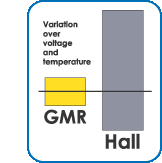 |
COMPARISON BULLETIN |
GMR Sensors Beat Hall Effect on Sensitivity, Precision, and Power
NVE sensors are based on revolutionary spintronic GMR rather
than old silicon Hall effect technology.
Sensitivity
NVE GMR sensors have 50 to 100 times the raw output signal of silicon Hall, allowing
lower switching fields for digital-output parts and larger airgaps between the
sensor and magnet in gear-tooth applications.
 Precision Precision
The large raw signal means GMR sensors are several times more precise than
silicon Hall over a wide range of temperature and supply voltages.
Power
The high impedance of GMR allows very low power operation. Typical continuous-duty
supply currents are 30 µA with 100 kHz frequency response. Duty-cycled
parts have supply currents as low as 100 nA with 30 Hz frequency response.
Flexibility
NVE offers custom versions of digital sensors with operate points in the range
of 7 to 80 Oe, depending on customer requirements. Custom gear tooth sensors
(ABL-Series) are also available to match customer target requirements. If you
don’t see what you want in our datasheets, contact NVE for a quotation on
a custom sensor.
Better
Here is a comparison of GMR versus Hall sensors:
| |
Lowest
Switching
Field |
Best
Operating Point
Precision |
Lowest Supply Current
|
Cost
|
| GMR Sensors |
7 Oe
(AFL005-10E) |
±10%
(BDH025-10E) |
0.1 µA
duty-cycled (ADL024-14E);
30 µA continuous-duty (ADL924-14E) |
Moderate |
| Hall
Effect |
~30 Oe |
±40% |
~5 µA duty-cycled;
~500 µA continuous-duty |
Cheap |
Questions or Comments
>
|